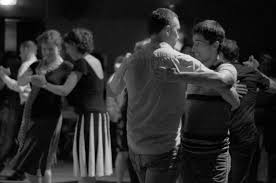Queer means anything that is not the norm.
 Queer Tango is a new way to dance Argentine tango. Traditionally the gentleman is the leader, and the lady follower. Sometimes also women dance mutually together, and less often men. One of them, or alternatively, they must adapt their roles.
Queer Tango is a new way to dance Argentine tango. Traditionally the gentleman is the leader, and the lady follower. Sometimes also women dance mutually together, and less often men. One of them, or alternatively, they must adapt their roles.
Queer Tango breaks the traditional hetero normative codes of dancing. Regardless of the sex, change the role of leader and follower.
There is danced in a gender- independent role between the same sex, or mixed.
The queer tango movement, supports the gay and lesbian movement, but also learns women to lead and men to follow.
Dancing alternately in both roles strengthens the mutual communication and promotes the feeling of each other's movements.
Gender roles in the traditional Argentine tango
Of conventional tango Is said it is a stronghold of heterosexism and machismo:
 "The tango is a duel for supremacy. Partner against partner, husband against wife.... "
"The tango is a duel for supremacy. Partner against partner, husband against wife.... "
- Gretchen Elizabeth Smith, The History of the Tango.
Dancing in a very intimate embrace - this intimacy defines tango as a "three - minute love affair" - the two gender roles - the man as a leader and the woman - follower are sexually defined:
Tango. The word evokes images of dancers with smoldering eyes and smoldering sensuality sliding on the melancholy music of Astor Piazzolla 's bandoneon. The men are masculine and women are, well, flatter their legs very striking to him.
- Dina - O'Meara, It takes two to tango.
Traditional tango is perfectly machismo culture, a reflection of the Argentine social attitudes about sexuality and gender relations. The man is the active participant, the woman passive.
Argentine tango is an improvisational dance. The man controls the direction of the step pattern and pace and protects the female follower who steps backwards in full confidence, even with closed eyes. She adds expressive elements at the dance: adornos (decorations). The man choreographer creates the structure of the dance so that the woman occurs well. The lady has to wait for the movements of her guide and with a bad leader, she can’t make anything of it.
In conventional milongas it is the man who invites the woman to dance with eye contact and a nod of the head, called cabeceó. Gender neutral dancing can reverse the roles and / or keep them amongst the same sex.
The term queer, or 'weird' is used as a synonym for the LGBT community, but it is here extended to a role reversal to improve one 's own expression. It would free the tango of the traditional rules and codes that limit the communication between people.
Reversing the roles helps tango dancers to improve their skills and choose a role.
History of Queer Tango movement
There is a known cliché: the tango was born in the brothels of Buenos Aires. Another cliché says that tango originated by men who for lack of women danced together on the streets at the beginning of the 20th century:
"Due to a shortage of women in the immigrant population, there were really only two practical ways for a man to get close to a woman. One was to go to a prostitute, and the other was to go dancing. The men practiced together on looking for the best ways to please the woman with whom they danced in preparation for that rare moment that they actually had a woman in their arms, were the men who created the tango as a dance."
- Christine Denniston, Clichés about Tango. Origins of the Dance
The Queer Tango movement recently returned to the origins of the tango with same-sex couples. It was founded in Germany in Hamburg, where in 2001 the first gay - lesbian milonga was organized. In the same year the First International Queer Tango Argentina Festival was born.
